

Bamboo Flutes
In August 2010, I started making bamboo flutes. My initial goal was to build a Bansuri, which is a traditional Indian bamboo flute with a beautiful sound and tuned to just intonation. In the meantime, I revised the goal, I will make bamboo flutes of any type (which, in fact, is much easier).
Right now just a few images of my first three flutes (there is one more, but it isn't quite finished) and the tools I use. More information will be added later.
Top: Bansuri prototype (b a g f e d c), most recent flute, bansuri-like hole position, only three holes here
Center: Bamboo flute (c# B A G F# E D), holes pretty small for bending, unfortunately a crack along the length of the flute,
but it doesn't harm the sound and this flute is pretty good, considering, that I am a noobish amateur.
Bottom: Prototype model flute (d c bb a g - natural minor), first working flute I've made.
I used insulating tape to reduce the risk of splitting while working on the flutes. The bottom
flute has twine instead, but two rings of insulating type to cover two holes that went sharp.
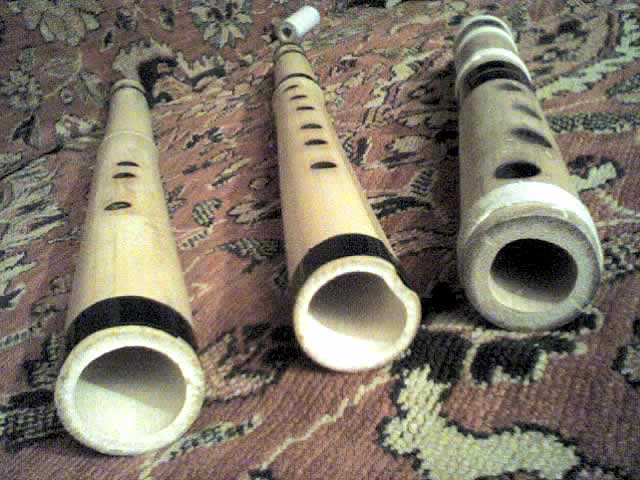
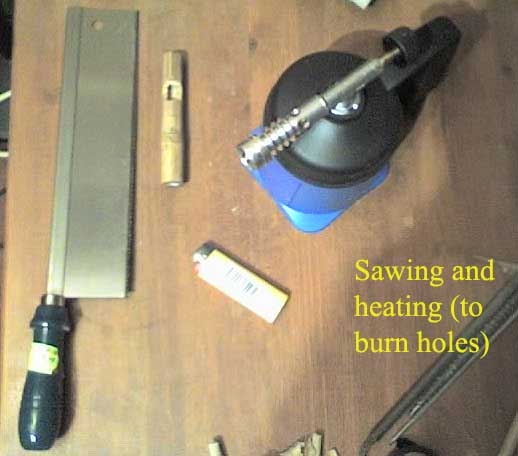
the bamboo is a handle for the drills as well as support for flutes when sawing.
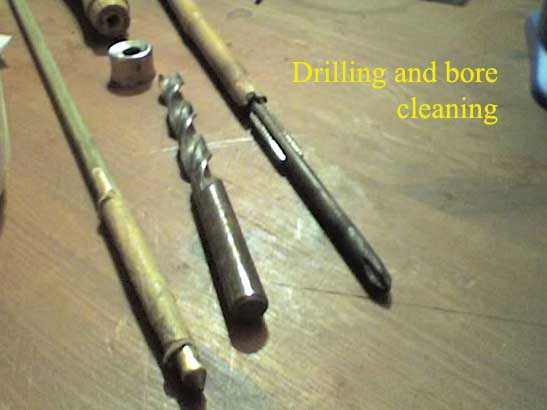
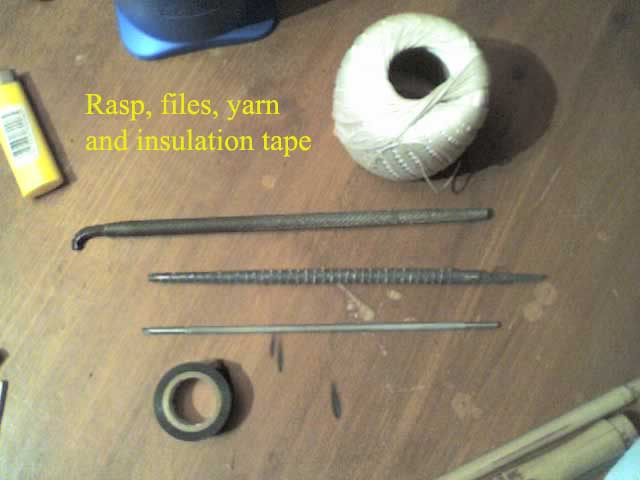


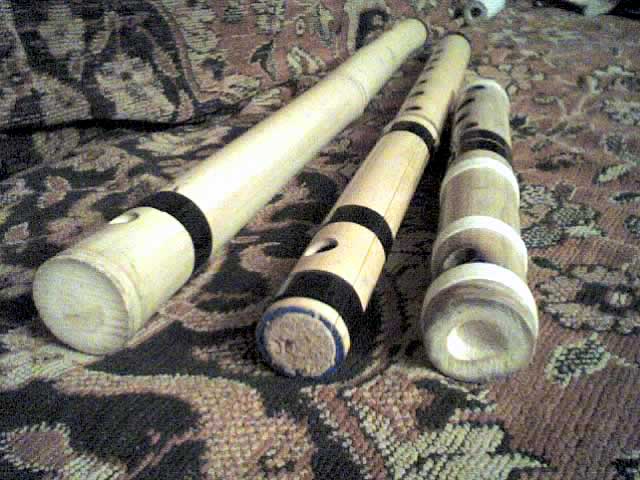
Basics of the Bansuri
There are several types of bansuris; one very important difference between them is the number of holes.
For the moment I will discuss 6-hole bansuris only, because I know these better than the others. The following
fingering chart is based on 6-hole bansuris; 7- and 8-hole bansuris are fingered in slightly different ways.
Bansuris are sort of tuned to two scales, Bilawal and Kalyan. If you define the lowest note of the flute as sa, the flute is tuned to Bilawal. If you define the lowest note to Pa, it is in Kalyan. The official scale is Kalyan and tuning is done to match this scale; therefore the alternative scale - Bilawal - is a bit out of tune.
Bansuris can play up to three octaves. The range depends very much on the quality of the flute. A higher "register", i.e. playing one octave higher, is reached by a different way of blowing. This is best explained by a qualified teacher. Beginners should really concentrate on the sound quality of the base register, as I can say now, that I do have a teacher.
Basic fingering chart for the first octave of 6-hole and 7-hole bansuris:
X for closed hole, O for open hole, O/ for half hole, embouchure is to the left.
Tivra Ma: O O O O O O
Shudda Ma: O/ O O O O O
Ga: X O O O O O
Re: X X O O O O
Sa: X X X O O O
Ni_: X X X X O O
Dha_: X X X X X O
Pa_: X X X X X X
Explanation of some specific things in Indian music
There are two different systems, Carnatic and Hindustani music. Carnatic is the system in the south, Hindustani in the north. Generally, Westerners recognize Hindustani, because of one of its most known representatives, Ravi Shankar. All said here is concerning Hindustani music, unless stated otherwise.
The notes of Indian music are as follows:
Sa Re Ga Ma Pa Dha Ni
Bilawal is the scale that uses exactly these notes, and it is the same as the western major scale, which is:
C D E F G A B (key of C).
Indian music is completely relative, the tonic or root note of any scale is always Sa. So, no matter, what
pitch Bilawal is played, it always starts with Sa. In western music, the major scale can start with any
note, the others will be sharp or flat where necessary. The Indian notes are rather equivalent to the solfege,
do re mi fa so la ti.
The Indian notes can be altered to get the pitches in between. This follows slightly different rules than
in western music. Sa and Pa can't be altered, Re, Ga, Dha and Ni can be flat and will be named "e;komal"e;
XX then (for example komal Re), Ma can be sharp, and is called "tivra Ma" then. Besides, the real
pitches can vary depending on the Raga (to read more on Raga, read http://en.wikipedia.org/wiki/Raga).
So, the chromatic scale is as follows:
Sa, komal Re, Re, komal Ga, Ga, Ma, tivra Ma, Pa, komal Dha, Dha, komal Ni, Ni.
Bilawal is one of many scales. It is exactly the same as our major scale.
Another important scale on Bansuris is Kalyan, because it is the "e;natural"e; scale when you have sa according
to the above fingering chart. It goes:
Sa, Re, Ga, tivra Ma, Pa, Dha, Ni.
The western equivalent to this is called Lydian scale and in C, it goes like this:
C, D, E, F#, G, A, B
On the natural notes (white keys on piano), it is the scale that starts with F:
F, G, A, B, C, D, E
This explains, why bansuris seem to have two scales. One that starts from the lowest note, but is not
considered the real scale - Bilawal, and the other one that is the basis for the fingering - Kalyan.
I found a few explanations for putting Sa to the middle of the flute rather than to the bottom, and I like
this one best:
Very often, you need to play around Sa, and therefore it is nice to have a couple of tones below and above it
that don't require to change the register.
to be continued...
Useful links: (will open in new window or tab)
www.fluteportal.com
Website and forum mainly for native american flutes, but it has a lot of valuable information
about flute making in general as well as very helpful members.
www.chandrakantha.com
very complete website about Indian music, has a forum too.
All material presented on this website is property of Guendola Media Productions
and may not be copied, printed, distributed or used in any other possible way
If you want to use any of this material, please contact us.